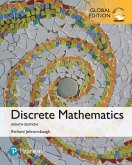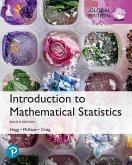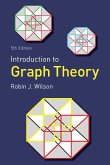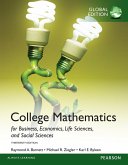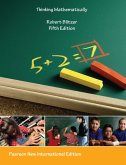Ralph P. Grimaldi
Discrete and Combinatorial Mathematics (eBook, PDF)
Pearson New International Edition
43,95 €
43,95 €
inkl. MwSt.
Sofort per Download lieferbar

22 °P sammeln
43,95 €
Als Download kaufen

43,95 €
inkl. MwSt.
Sofort per Download lieferbar

22 °P sammeln
Jetzt verschenken
Alle Infos zum eBook verschenken
43,95 €
inkl. MwSt.
Sofort per Download lieferbar
Alle Infos zum eBook verschenken

22 °P sammeln
Ralph P. Grimaldi
Discrete and Combinatorial Mathematics (eBook, PDF)
Pearson New International Edition
- Format: PDF
- Merkliste
- Auf die Merkliste
- Bewerten Bewerten
- Teilen
- Produkt teilen
- Produkterinnerung
- Produkterinnerung

Bitte loggen Sie sich zunächst in Ihr Kundenkonto ein oder registrieren Sie sich bei
bücher.de, um das eBook-Abo tolino select nutzen zu können.
Hier können Sie sich einloggen
Hier können Sie sich einloggen
Sie sind bereits eingeloggt. Klicken Sie auf 2. tolino select Abo, um fortzufahren.

Bitte loggen Sie sich zunächst in Ihr Kundenkonto ein oder registrieren Sie sich bei bücher.de, um das eBook-Abo tolino select nutzen zu können.
This fifth edition continues to improve on the features that have made it the market leader. The text offers a flexible organization, enabling instructors to adapt the book to their particular courses. The book is both complete and careful, and it continues to maintain its emphasis on algorithms and applications. Excellent exercise sets allow students to perfect skills as they practice. This new edition continues to feature numerous computer science applications-making this the ideal text for preparing students for advanced study.
- Geräte: PC
- ohne Kopierschutz
- eBook Hilfe
- Größe: 10.86MB
Andere Kunden interessierten sich auch für
![Discrete Mathematical Structures (eBook, PDF) Discrete Mathematical Structures (eBook, PDF)]() Bernard KolmanDiscrete Mathematical Structures (eBook, PDF)43,95 €
Bernard KolmanDiscrete Mathematical Structures (eBook, PDF)43,95 €![Discrete Mathematics, Global Edition (eBook, PDF) Discrete Mathematics, Global Edition (eBook, PDF)]() Richard JohnsonbaughDiscrete Mathematics, Global Edition (eBook, PDF)43,95 €
Richard JohnsonbaughDiscrete Mathematics, Global Edition (eBook, PDF)43,95 €![Introduction to Mathematical Statistics, Global Edition (eBook, PDF) Introduction to Mathematical Statistics, Global Edition (eBook, PDF)]() Robert V. HoggIntroduction to Mathematical Statistics, Global Edition (eBook, PDF)43,95 €
Robert V. HoggIntroduction to Mathematical Statistics, Global Edition (eBook, PDF)43,95 €![Problem Solving Approach to Mathematics for Elementary School Teachers, A (eBook, PDF) Problem Solving Approach to Mathematics for Elementary School Teachers, A (eBook, PDF)]() Rick BillsteinProblem Solving Approach to Mathematics for Elementary School Teachers, A (eBook, PDF)43,95 €
Rick BillsteinProblem Solving Approach to Mathematics for Elementary School Teachers, A (eBook, PDF)43,95 €![Introduction to Graph Theory uPDF eBook (eBook, PDF) Introduction to Graph Theory uPDF eBook (eBook, PDF)]() Robin J. WilsonIntroduction to Graph Theory uPDF eBook (eBook, PDF)25,95 €
Robin J. WilsonIntroduction to Graph Theory uPDF eBook (eBook, PDF)25,95 €![College Math for Business, Economics, Life Sciences & Social Sciences PDF eBook, Global Edition (eBook, PDF) College Math for Business, Economics, Life Sciences & Social Sciences PDF eBook, Global Edition (eBook, PDF)]() Raymond A. BarnettCollege Math for Business, Economics, Life Sciences & Social Sciences PDF eBook, Global Edition (eBook, PDF)43,95 €
Raymond A. BarnettCollege Math for Business, Economics, Life Sciences & Social Sciences PDF eBook, Global Edition (eBook, PDF)43,95 €![Thinking Mathematically (eBook, PDF) Thinking Mathematically (eBook, PDF)]() Robert F. BlitzerThinking Mathematically (eBook, PDF)43,95 €
Robert F. BlitzerThinking Mathematically (eBook, PDF)43,95 €-
-
-
This fifth edition continues to improve on the features that have made it the market leader. The text offers a flexible organization, enabling instructors to adapt the book to their particular courses. The book is both complete and careful, and it continues to maintain its emphasis on algorithms and applications. Excellent exercise sets allow students to perfect skills as they practice. This new edition continues to feature numerous computer science applications-making this the ideal text for preparing students for advanced study.
Dieser Download kann aus rechtlichen Gründen nur mit Rechnungsadresse in A, B, BG, CY, CZ, D, DK, EW, E, FIN, F, GR, HR, H, IRL, I, LT, L, LR, M, NL, PL, P, R, S, SLO, SK ausgeliefert werden.
Produktdetails
- Produktdetails
- Verlag: Pearson HigherEducation
- Seitenzahl: 936
- Altersempfehlung: ab 18 Jahre
- Erscheinungstermin: 28. August 2013
- Englisch
- ISBN-13: 9781292035994
- Artikelnr.: 41939849
- Verlag: Pearson HigherEducation
- Seitenzahl: 936
- Altersempfehlung: ab 18 Jahre
- Erscheinungstermin: 28. August 2013
- Englisch
- ISBN-13: 9781292035994
- Artikelnr.: 41939849
- Herstellerkennzeichnung Die Herstellerinformationen sind derzeit nicht verfügbar.
PART 1. FUNDAMENTALS OF DISCRETE MATHEMATICS.
1. Fundamental Principles of Counting.
The Rules of Sum and Product.
Permutations.
Combinations: The Binomial Theorem.
Combinations with Repetition.
The Catalan Numbers (Optional).
Summary and Historical Review.
2. Fundamentals of Logic.
Basic Connectives and Truth Tables.
Logical Equivalence: The Laws of Logic.
Logical Implication: Rules of Inference.
The Use of Quantifiers.
Quantifiers, Definitions, and the Proofs of Theorems.
Summary and Historical Review.
3. Set Theory.
Sets and Subsets.
Set Operations and the Laws of Set Theory.
Counting and Venn Diagrams.
A First Word on Probability.
The Axioms of Probability (Optional).
Conditional Probability: Independence (Optional).
Discrete Random Variables (Optional).
Summary and Historical Review.
4. Properties of the Integers: Mathematical Induction.
The Well-Ordering Principle: Mathematical Induction.
Recursive Definitions.
The Division Algorithm: Prime Numbers.
The Greatest Common Divisor: The Euclidean Algorithm.
The Fundamental Theorem of Arithmetic.
Summary and Historical Review.
5. Relations and Functions.
Cartesian Products and Relations.
Functions: Plain and One-to-One.
Onto Functions: Stirling Numbers of the Second Kind.
Special Functions.
The Pigeonhole Principle.
Function Composition and Inverse Functions.
Computational Complexity.
Analysis of Algorithms.
Summary and Historical Review.
6. Languages: Finite State Machines.
Language: The Set Theory of Strings.
Finite State Machines: A First Encounter.
Finite State Machines: A Second Encounter.
Summary and Historical Review.
7. Relations: The Second Time Around.
Relations Revisited: Properties of Relations.
Computer Recognition: Zero-One Matrices and Directed Graphs.
Partial Orders: Hasse Diagrams.
Equivalence Relations and Partitions.
Finite State Machines: The Minimization Process.
Summary and Historical Review.
PART 2. FURTHER TOPICS IN ENUMERATION.
8. The Principle of Inclusion and Exclusion.
The Principle of Inclusion and Exclusion.
Generalizations of the Principle.
Derangements: Nothing Is in Its Right Place.
Rook Polynomials.
Arrangements with Forbidden Positions.
Summary and Historical Review.
9. Generating Functions.
Introductory Examples.
Definition and Examples: Calculational Techniques.
Partitions of Integers.
The Exponential Generating Functions.
The Summation Operator.
Summary and Historical Review.
10. Recurrence Relations.
1. Fundamental Principles of Counting.
The Rules of Sum and Product.
Permutations.
Combinations: The Binomial Theorem.
Combinations with Repetition.
The Catalan Numbers (Optional).
Summary and Historical Review.
2. Fundamentals of Logic.
Basic Connectives and Truth Tables.
Logical Equivalence: The Laws of Logic.
Logical Implication: Rules of Inference.
The Use of Quantifiers.
Quantifiers, Definitions, and the Proofs of Theorems.
Summary and Historical Review.
3. Set Theory.
Sets and Subsets.
Set Operations and the Laws of Set Theory.
Counting and Venn Diagrams.
A First Word on Probability.
The Axioms of Probability (Optional).
Conditional Probability: Independence (Optional).
Discrete Random Variables (Optional).
Summary and Historical Review.
4. Properties of the Integers: Mathematical Induction.
The Well-Ordering Principle: Mathematical Induction.
Recursive Definitions.
The Division Algorithm: Prime Numbers.
The Greatest Common Divisor: The Euclidean Algorithm.
The Fundamental Theorem of Arithmetic.
Summary and Historical Review.
5. Relations and Functions.
Cartesian Products and Relations.
Functions: Plain and One-to-One.
Onto Functions: Stirling Numbers of the Second Kind.
Special Functions.
The Pigeonhole Principle.
Function Composition and Inverse Functions.
Computational Complexity.
Analysis of Algorithms.
Summary and Historical Review.
6. Languages: Finite State Machines.
Language: The Set Theory of Strings.
Finite State Machines: A First Encounter.
Finite State Machines: A Second Encounter.
Summary and Historical Review.
7. Relations: The Second Time Around.
Relations Revisited: Properties of Relations.
Computer Recognition: Zero-One Matrices and Directed Graphs.
Partial Orders: Hasse Diagrams.
Equivalence Relations and Partitions.
Finite State Machines: The Minimization Process.
Summary and Historical Review.
PART 2. FURTHER TOPICS IN ENUMERATION.
8. The Principle of Inclusion and Exclusion.
The Principle of Inclusion and Exclusion.
Generalizations of the Principle.
Derangements: Nothing Is in Its Right Place.
Rook Polynomials.
Arrangements with Forbidden Positions.
Summary and Historical Review.
9. Generating Functions.
Introductory Examples.
Definition and Examples: Calculational Techniques.
Partitions of Integers.
The Exponential Generating Functions.
The Summation Operator.
Summary and Historical Review.
10. Recurrence Relations.
PART 1. FUNDAMENTALS OF DISCRETE MATHEMATICS.
1. Fundamental Principles of Counting.
The Rules of Sum and Product.
Permutations.
Combinations: The Binomial Theorem.
Combinations with Repetition.
The Catalan Numbers (Optional).
Summary and Historical Review.
2. Fundamentals of Logic.
Basic Connectives and Truth Tables.
Logical Equivalence: The Laws of Logic.
Logical Implication: Rules of Inference.
The Use of Quantifiers.
Quantifiers, Definitions, and the Proofs of Theorems.
Summary and Historical Review.
3. Set Theory.
Sets and Subsets.
Set Operations and the Laws of Set Theory.
Counting and Venn Diagrams.
A First Word on Probability.
The Axioms of Probability (Optional).
Conditional Probability: Independence (Optional).
Discrete Random Variables (Optional).
Summary and Historical Review.
4. Properties of the Integers: Mathematical Induction.
The Well-Ordering Principle: Mathematical Induction.
Recursive Definitions.
The Division Algorithm: Prime Numbers.
The Greatest Common Divisor: The Euclidean Algorithm.
The Fundamental Theorem of Arithmetic.
Summary and Historical Review.
5. Relations and Functions.
Cartesian Products and Relations.
Functions: Plain and One-to-One.
Onto Functions: Stirling Numbers of the Second Kind.
Special Functions.
The Pigeonhole Principle.
Function Composition and Inverse Functions.
Computational Complexity.
Analysis of Algorithms.
Summary and Historical Review.
6. Languages: Finite State Machines.
Language: The Set Theory of Strings.
Finite State Machines: A First Encounter.
Finite State Machines: A Second Encounter.
Summary and Historical Review.
7. Relations: The Second Time Around.
Relations Revisited: Properties of Relations.
Computer Recognition: Zero-One Matrices and Directed Graphs.
Partial Orders: Hasse Diagrams.
Equivalence Relations and Partitions.
Finite State Machines: The Minimization Process.
Summary and Historical Review.
PART 2. FURTHER TOPICS IN ENUMERATION.
8. The Principle of Inclusion and Exclusion.
The Principle of Inclusion and Exclusion.
Generalizations of the Principle.
Derangements: Nothing Is in Its Right Place.
Rook Polynomials.
Arrangements with Forbidden Positions.
Summary and Historical Review.
9. Generating Functions.
Introductory Examples.
Definition and Examples: Calculational Techniques.
Partitions of Integers.
The Exponential Generating Functions.
The Summation Operator.
Summary and Historical Review.
10. Recurrence Relations.
1. Fundamental Principles of Counting.
The Rules of Sum and Product.
Permutations.
Combinations: The Binomial Theorem.
Combinations with Repetition.
The Catalan Numbers (Optional).
Summary and Historical Review.
2. Fundamentals of Logic.
Basic Connectives and Truth Tables.
Logical Equivalence: The Laws of Logic.
Logical Implication: Rules of Inference.
The Use of Quantifiers.
Quantifiers, Definitions, and the Proofs of Theorems.
Summary and Historical Review.
3. Set Theory.
Sets and Subsets.
Set Operations and the Laws of Set Theory.
Counting and Venn Diagrams.
A First Word on Probability.
The Axioms of Probability (Optional).
Conditional Probability: Independence (Optional).
Discrete Random Variables (Optional).
Summary and Historical Review.
4. Properties of the Integers: Mathematical Induction.
The Well-Ordering Principle: Mathematical Induction.
Recursive Definitions.
The Division Algorithm: Prime Numbers.
The Greatest Common Divisor: The Euclidean Algorithm.
The Fundamental Theorem of Arithmetic.
Summary and Historical Review.
5. Relations and Functions.
Cartesian Products and Relations.
Functions: Plain and One-to-One.
Onto Functions: Stirling Numbers of the Second Kind.
Special Functions.
The Pigeonhole Principle.
Function Composition and Inverse Functions.
Computational Complexity.
Analysis of Algorithms.
Summary and Historical Review.
6. Languages: Finite State Machines.
Language: The Set Theory of Strings.
Finite State Machines: A First Encounter.
Finite State Machines: A Second Encounter.
Summary and Historical Review.
7. Relations: The Second Time Around.
Relations Revisited: Properties of Relations.
Computer Recognition: Zero-One Matrices and Directed Graphs.
Partial Orders: Hasse Diagrams.
Equivalence Relations and Partitions.
Finite State Machines: The Minimization Process.
Summary and Historical Review.
PART 2. FURTHER TOPICS IN ENUMERATION.
8. The Principle of Inclusion and Exclusion.
The Principle of Inclusion and Exclusion.
Generalizations of the Principle.
Derangements: Nothing Is in Its Right Place.
Rook Polynomials.
Arrangements with Forbidden Positions.
Summary and Historical Review.
9. Generating Functions.
Introductory Examples.
Definition and Examples: Calculational Techniques.
Partitions of Integers.
The Exponential Generating Functions.
The Summation Operator.
Summary and Historical Review.
10. Recurrence Relations.


